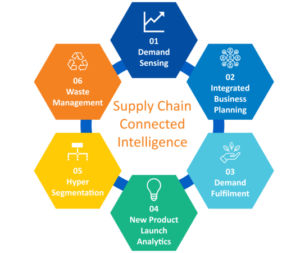Supply Chain Connected Intelligence: Navigating Challenges and Creating Value
Omnichannel business models are the order of the day, and increasing complexity within the supply chain is a byproduct of this phenomenon. Today’s business landscape has companies, suppliers, partners, consumers, and customer support, all operating with their unique infrastructure and processes.
There is a dire need for a unified supply chain management platform that can streamline all the elements that comprise an enterprise. Having a single platform to connect all the business functions within the supply chain, is the key to data transparency across functions. This drives increased operational efficiency, agility, and sustainability, enabling enterprises to optimize the revenue generated.
So, let’s get a better understanding of what it means to have a connected supply chain and how it can support your enterprise.
Connected Supply Chain – Driving Connectivity & Transparency
A connected supply chain is all about unifying siloed business units, offering complete transparency into enterprise data in real-time. It is a single system where every business function communicates seamlessly, shares data, generates insights and offers value to every key account manager and decision-maker.
With IoT, Cloud, and edge devices being integrated with AI and machine learning (ML) models, enterprises can offer complete connectivity and transparency to drive smarter, more flexible, and increasingly agile ways of working across the entire supply chain.
With predictive and prescriptive analytics capabilities coming into play, “connected intelligence” becomes of greater value. For example, the supply chain connected intelligence platform can inform a company’s product manufacturing unit about a spike in demand for a particular product, without human intervention. The platform analyzes product sales to identify the spike and simultaneously analyzes the inventory data to check if there are enough SKUs to match the demand. Prescriptive insights are delivered through automation, and the enterprise doesn’t lose out on an opportunity.
Here’s a quick video on some use cases of connected intelligence facilitated by an integrated AI-powered platform, and the advantages offered to different user personas.
But there are certain challenges and priorities that enterprises need to be cognizant of.
Setting up a Connected Supply Chain – Key Considerations
COVID-19 has been one of the primary drivers of change in the global supply chain. There has been a sharp uptick in e-commerce and D2C engagements, with demand cycles becoming shorter. As consumers demand greater convenience and delivery speed, enterprises are being faced with greater demand volatility, increasing costs for production and transportation, and logistics complexities.
Enterprises are striving to adopt increasingly agile supply chain management systems. They are aiming to optimize the costs and enhance the efficiency of the supply chain; to reduce waste, identify trends, and deliver superior customer experiences.
To truly generate value from a connected supply chain, enterprises need to execute the core functions in a connected, contextual, and continuous cycle, which will be scalable and sustainable.
Adopting a Connected Supply Chain with a Unified Platform
The following are six functions that need to be part of the core competency of an agile platform for supply chain connected intelligence:
With an integrated platform operating on the cloud, and unifying disparate data silos and business functions, decision-makers and key account managers can view the organization as a whole. A single command center for enterprise data offering prescriptive analytics and causal analytics insights enables them to effectively take decisions at both a micro and a macro level.
Enterprises can now deliver premium customer experiences with an optimized supply chain, while simultaneously addressing the organizational objectives, which in turn will generate further value.
Final Thoughts
I hope this blog offers you some crucial insights into the need for a connected supply chain and the benefits it offers to enterprises big and small.
If you are interested in a more detailed view of the subject or are interested in upgrading your supply chain with an agile platform for connected intelligence, we have an exclusive whitepaper to guide you through it.
At Course5 Intelligence, we help enterprises accelerate their digital transformation through custom solutions and our proprietary products for AI-powered business intelligence. If you need assistance with integrating a robust Supply Chain Analytics Solution, we would be happy to help.
Don’t miss our next article!
Sign up to get the latest perspectives on analytics, insights, and AI.





